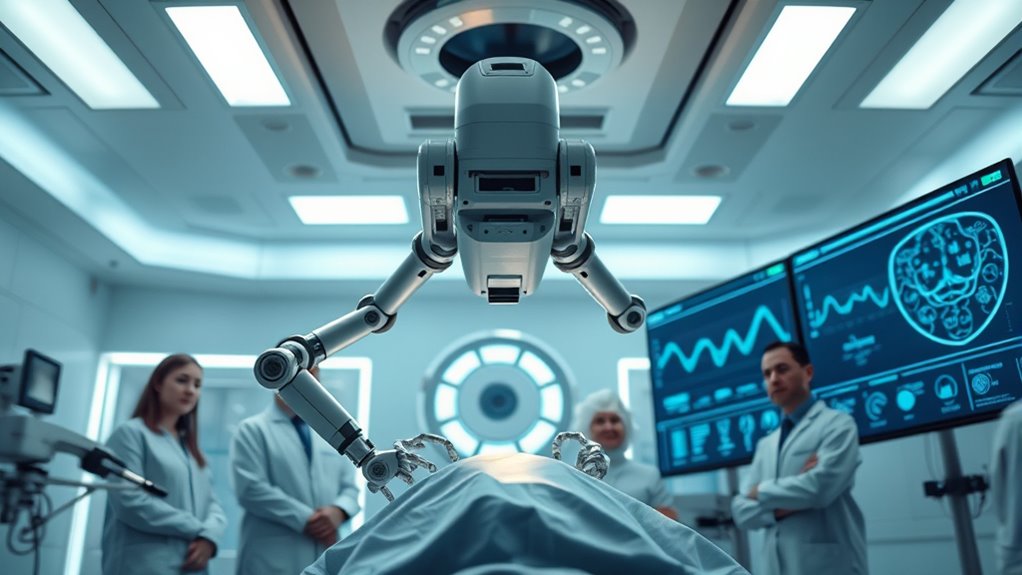Automation in healthcare is transforming your industry by integrating robots, AI, and data analytics to speed up diagnoses, improve surgeries, and streamline operations. While these advances enhance patient care and reduce errors, they also shift job roles, reducing administrative tasks but increasing demand for tech-savvy professionals. Challenges include ensuring safety, privacy, and ethical use. To understand how these changes are shaping healthcare jobs and what lies ahead, keep exploring this evolving landscape.
Key Takeaways
- Automation enhances surgical precision and diagnostic speed, reducing manual roles and transforming healthcare job functions.
- Growing demand for AI specialists, data analysts, and robot maintenance roles offsets declines in administrative positions.
- Healthcare workers need new technical skills to oversee automated systems and interpret AI-driven insights.
- Ethical and safety concerns require ongoing training and transparent practices to maintain trust and accountability.
- Overall job landscape shifts toward collaborative human-AI work, emphasizing continuous learning and adaptation.
The Evolution of Automation Technologies in Healthcare
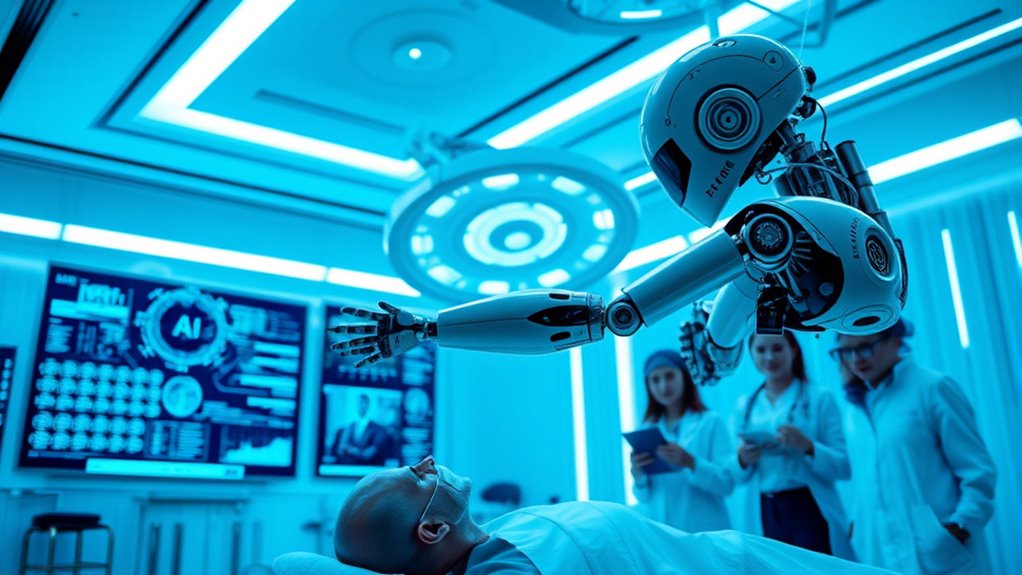
The evolution of automation technologies in healthcare has been rapid and transformative, driven by advances in artificial intelligence, robotics, and data analytics. You’ve seen how AI now helps in diagnosing diseases more accurately and swiftly, reducing human error. Robots assist in surgeries, providing precision that surpasses manual techniques, and streamline repetitive tasks like inventory management and patient monitoring. Data analytics enable healthcare providers to predict outbreaks, optimize resource allocation, and personalize treatment plans. Additionally, the integration of these technologies has increased the productivity of healthcare systems, leading to more efficient patient care. Over the years, the integration of these technologies has increased efficiency and improved patient outcomes. The market’s growth reflects this shift, with projections indicating a rise to nearly $96 billion by 2034. This evolution continues to reshape healthcare delivery, pushing it toward more intelligent, automated systems that benefit providers and patients alike.
Transforming Medical Procedures and Patient Care
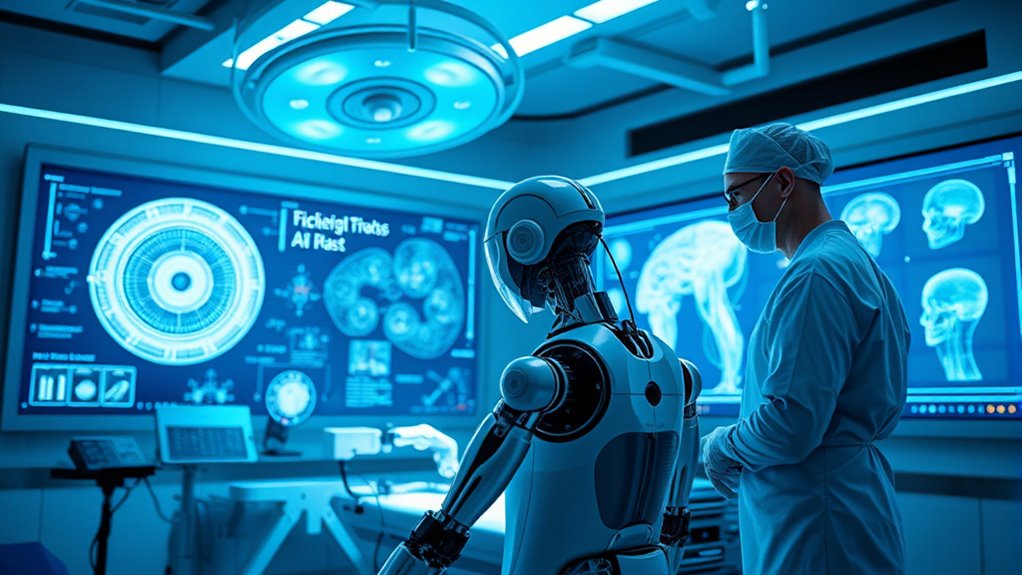
Advancements in healthcare automation are revolutionizing medical procedures and patient care by increasing precision, efficiency, and safety. You now benefit from minimally invasive surgeries guided by robotic systems, which reduce recovery times and complication risks. AI-driven diagnostic tools analyze vast data quickly, providing more accurate and early detection of conditions. Automated imaging and real-time monitoring enable clinicians to make faster, better-informed decisions. Telemedicine platforms powered by automation connect you to specialists regardless of location, ensuring timely care. Additionally, automation assists in managing patient records seamlessly, reducing errors and streamlining workflows. Recognizing the importance of ethical hacking in safeguarding healthcare systems, cybersecurity professionals are essential in protecting sensitive patient information from cyber threats. These innovations lead to personalized treatment plans, improved outcomes, and a more patient-centered approach. Overall, automation transforms your healthcare experience into safer, more efficient, and highly precise.
The Impact on Healthcare Workforce Dynamics
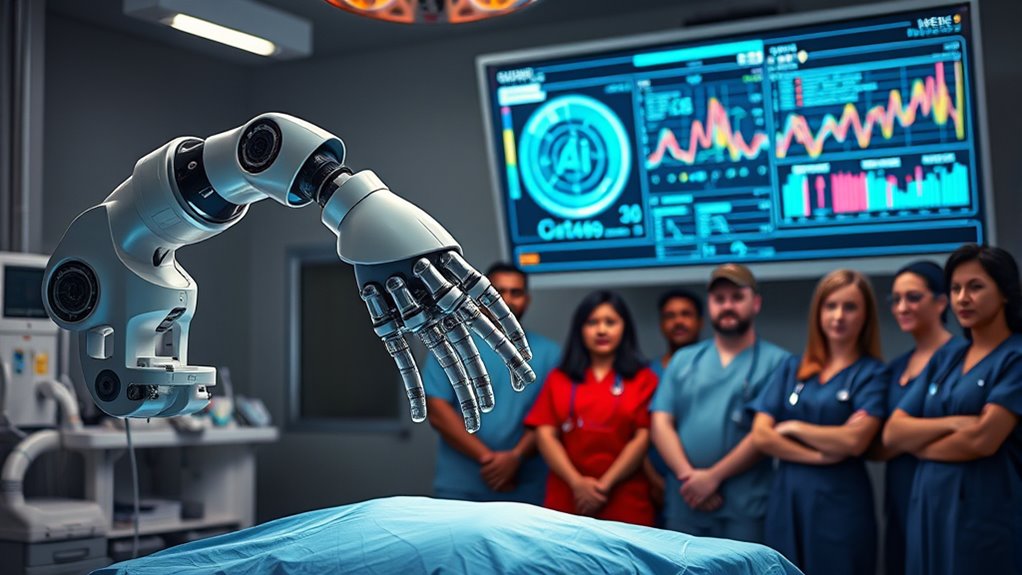
As healthcare automation becomes more widespread, it markedly reshapes workforce dynamics by changing roles, skill requirements, and staffing needs. You’ll find traditional tasks shifting from manual procedures to technology-driven processes, requiring staff to develop new technical skills. Some roles, like administrative positions, may decline as automated systems handle scheduling and documentation more efficiently. Conversely, demand for specialists in AI, data analysis, and robot maintenance will grow. You’ll also notice a move toward more collaborative work, where humans oversee and interpret automated outputs. Staffing models will adapt to emphasize flexibility, with a focus on continuous training. Additionally, understanding medical device integration will become increasingly vital for healthcare professionals to effectively manage automated systems. Overall, automation leads to a more specialized, tech-savvy workforce that balances human expertise with machine efficiency, fundamentally transforming how healthcare teams operate daily.
Challenges and Ethical Considerations in Automation Adoption
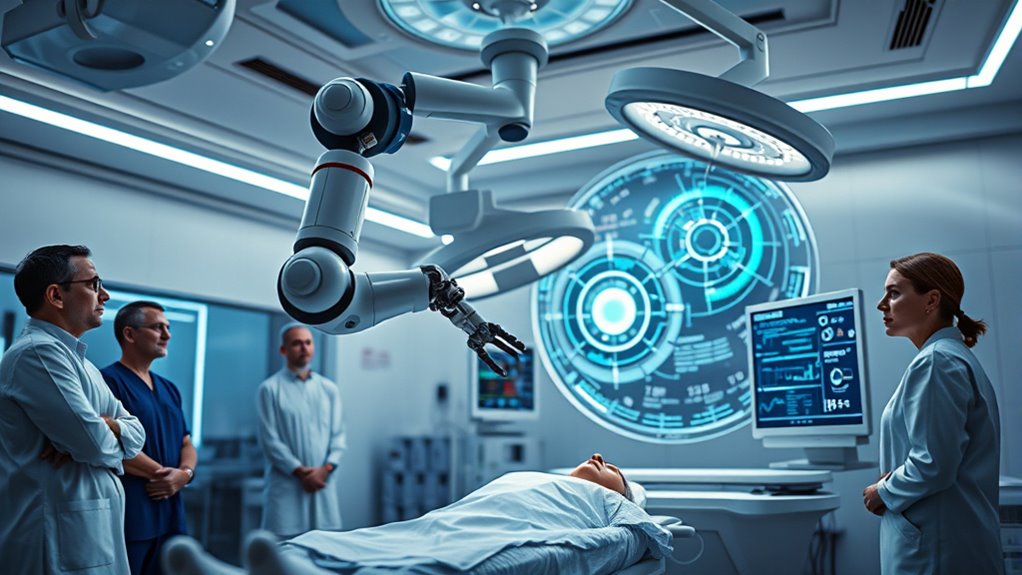
Implementing automation in healthcare introduces significant challenges and ethical considerations that stakeholders must address. You need to guarantee patient safety and data privacy amid increasing reliance on AI and robotic systems. Biases in algorithms can lead to unfair treatment, so you must scrutinize and mitigate these issues. Transparency is vital; patients and providers should understand how decisions are made. Resistance from healthcare professionals may arise due to fears of job loss or diminished roles, requiring you to manage change carefully. Ethical dilemmas also emerge around accountability—who’s responsible if an AI system makes an error? Balancing technological innovation with ethical standards is essential to maintain trust, ensure equitable care, and prevent unintended consequences as automation becomes more integrated into healthcare. Additionally, cultivating a mindset that embraces creative practice can help teams develop innovative solutions to these complex challenges.
Future Outlook: Embracing Innovation While Managing Change
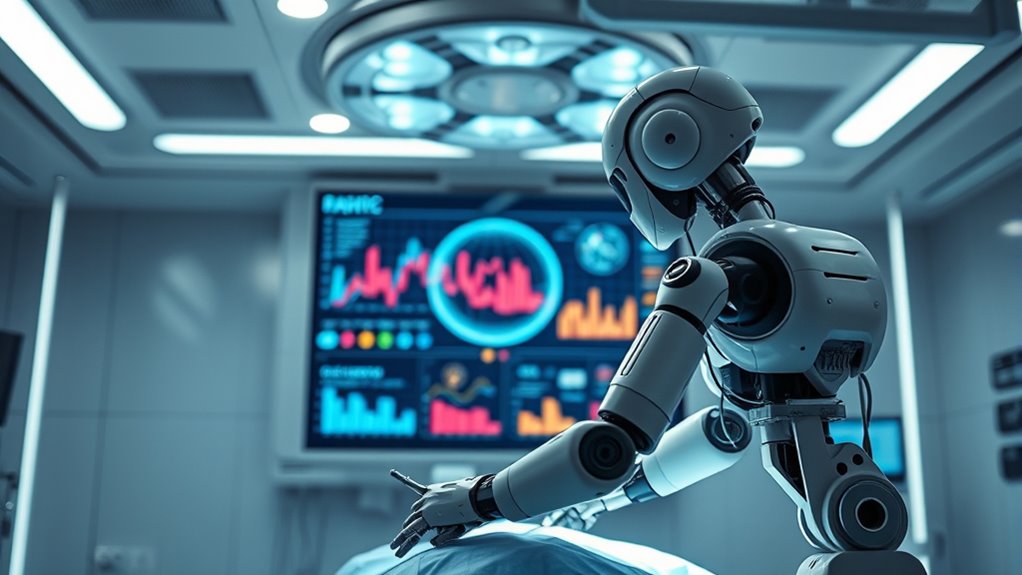
The future of healthcare automation hinges on balancing innovative technologies with effective change management. You’ll need to stay adaptable as new tools emerge and workflows evolve. Embracing innovation means continuously updating skills and workflows to leverage AI, robotics, and data analytics effectively. At the same time, you must manage change thoughtfully—communicating clearly, addressing concerns, and providing training to guarantee smooth transitions. The rapid growth of the AI healthcare market, projected to hit $188 billion by 2030, underscores the importance of proactive adoption. By fostering a culture of learning and openness, you can harness automation’s benefits—like reduced hospital stays and improved diagnostics—while minimizing disruptions. Ensuring high color accuracy in diagnostic imaging and projectors is also crucial for precise interpretation and outcomes. Striking this balance will position you to improve patient care and stay competitive in a transforming industry.
Frequently Asked Questions
How Will Automation Affect Healthcare Costs for Patients?
Automation is likely to lower your healthcare costs over time by streamlining processes, reducing hospital stays, and increasing efficiency. With AI-driven diagnostics and robotic surgeries, you may see fewer unnecessary tests and faster treatment, saving you money. Although initial investments are high, the long-term savings and improved care quality could make healthcare more affordable for you and others, ensuring better outcomes at lower prices.
What Training Will Healthcare Workers Need to Adapt to New Technologies?
You’ll need ongoing training in AI and robotics to stay current, as the global AI healthcare market is expected to reach $188 billion by 2030. Embrace courses on machine learning, data analysis, and new medical technologies. Hands-on experience with automation tools will boost your skills, making you more adaptable. Continuous learning will help you work effectively alongside advanced systems, ensuring you remain valuable in an evolving healthcare landscape.
Are There Risks of Job Displacement in the Healthcare Sector?
You should be aware that automation could displace some healthcare jobs, especially repetitive tasks like data entry or scheduling. However, new roles will also emerge, requiring skills in managing and maintaining advanced technologies. To stay relevant, you need ongoing training in digital tools and AI systems. Embracing these changes can help you adapt, ensuring you remain an essential part of patient care and healthcare innovation.
How Do Automation Systems Ensure Patient Privacy and Data Security?
Protect patient privacy and data security with precision and proactive policies. You’ll want to implement robust encryption, rigorous access controls, and regular audits that deter data breaches. Prioritize compliance with privacy laws like HIPAA, and promote transparency around data usage. By practicing proactive protections, you guarantee sensitive information stays secure, safeguarding trust while seamlessly supporting automation systems. This strategic safeguarding sustains security, privacy, and patient confidence in a rapidly evolving healthcare landscape.
Will Automation Lead to Reduced Human Interaction in Patient Care?
Automation may reduce some face-to-face interactions, but it also enhances patient care by streamlining processes and reducing errors. You’ll find more time for meaningful conversations with patients, focusing on emotional support and personalized treatment. Technology handles routine tasks efficiently, freeing you up to build stronger relationships. While automation changes how care is delivered, it ultimately supports and enriches the human connection that’s essential to healthcare.
Conclusion
As you marvel at robot surgeons and AI diagnosticians transforming healthcare, it’s ironic how technology promises precision while sometimes complicating jobs. You might think automation frees humans, but it often reshapes roles, demanding new skills and resilience. So, as you embrace this brave new world of innovation, remember—sometimes, the greatest breakthroughs come with the unexpected twist of human adaptation. After all, progress isn’t just about machines; it’s about how you, and your colleagues, keep up with them.
